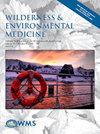Creation of an Emergency Care Capacity Assessment Tool for Facilities in Austere Environments.
IF 1.4
4区 医学
Q3 PUBLIC, ENVIRONMENTAL & OCCUPATIONAL HEALTH
引用次数: 0
Abstract
INTRODUCTION Facilities in austere environments may consider emergency care beyond their scope. Often patients with high-acuity conditions have no other choice than to present to these facilities. The disconnect between the intent of health systems planners and the reality faced by providers manifests as facilities unable to manage such cases.The Indian Health Service, with a range of stakeholders, developed an emergency care delivery assessment tool for facilities in austere environments, designed to identify deficiencies in facility readiness for emergency care delivery across four areas: 1. Procedural2. Human resources3. Non-pharmacologic material resources4. Pharmacologic material resources. METHODS The tool's underlying architecture is a resource matrix similar to hospital-based tools, using the "Facility" component of the WHO Emergency Care Systems Framework as the Y-axis and undifferentiated presentations taught by the WHO basic emergency care course, advanced trauma life support, and advanced life support in obstetrics as the X-axis. The tool was piloted at a remote frontier clinic. RESULTS We found 48 deficiencies: 7 procedural, 1 human resources, 31 non-pharmacologic materials, and 9 pharmacologic materials. We aggregated deficiencies by facility function to assess the capacity to perform each. We also aggregated deficiencies by clinical presentation to identify targets for educational interventions. CONCLUSION We successfully created a novel emergency care capacity assessment tool for use in austere environments using materials with broad international consensus. The successful pilot found deficiencies across all 4 areas. This tool may be useful in many other remote domestic facilities and rural health posts in low- and middle-income countries.为环境恶劣的设施创建紧急救护能力评估工具。
引言环境恶劣的医疗机构可能会认为急诊护理超出了他们的范围。通常情况下,病情危重的病人除了到这些机构就诊别无选择。医疗系统规划者的意图与医疗服务提供者所面临的现实之间的脱节,表现为医疗机构无法处理此类病例。印第安人医疗服务机构与一系列利益相关者共同开发了一种针对艰苦环境下医疗机构的急诊医疗服务评估工具,旨在从四个方面确定医疗机构在急诊医疗服务准备方面的不足:1.程序2.人力资源3.非药物物质资源4.该工具的基本架构是一个资源矩阵,类似于基于医院的工具,以世界卫生组织紧急救护系统框架的 "设施 "部分为 Y 轴,以世界卫生组织基本紧急救护课程、高级创伤生命支持和产科高级生命支持所教授的无差别演示为 X 轴。该工具在一家偏远的边疆诊所试用:我们发现了 48 项缺陷:7 项程序性缺陷、1 项人力资源缺陷、31 项非药物性缺陷和 9 项药物性缺陷。我们按设施功能汇总了缺陷,以评估执行每项功能的能力。我们还按临床表现汇总了不足之处,以确定教育干预的目标。结论我们成功地创建了一种新型急救能力评估工具,该工具可在艰苦环境中使用,使用的材料已在国际上达成广泛共识。成功的试点发现了所有 4 个方面的不足。该工具可能适用于中低收入国家的许多其他偏远国内设施和农村医疗站。
本文章由计算机程序翻译,如有差异,请以英文原文为准。
求助全文
约1分钟内获得全文
求助全文
来源期刊

Wilderness & Environmental Medicine
医学-公共卫生、环境卫生与职业卫生
CiteScore
2.10
自引率
7.10%
发文量
96
审稿时长
>12 weeks
期刊介绍:
Wilderness & Environmental Medicine, the official journal of the Wilderness Medical Society, is the leading journal for physicians practicing medicine in austere environments. This quarterly journal features articles on all aspects of wilderness medicine, including high altitude and climbing, cold- and heat-related phenomena, natural environmental disasters, immersion and near-drowning, diving, and barotrauma, hazardous plants/animals/insects/marine animals, animal attacks, search and rescue, ethical and legal issues, aeromedial transport, survival physiology, medicine in remote environments, travel medicine, operational medicine, and wilderness trauma management. It presents original research and clinical reports from scientists and practitioners around the globe. WEM invites submissions from authors who want to take advantage of our established publication''s unique scope, wide readership, and international recognition in the field of wilderness medicine. Its readership is a diverse group of medical and outdoor professionals who choose WEM as their primary wilderness medical resource.
 求助内容:
求助内容: 应助结果提醒方式:
应助结果提醒方式:


